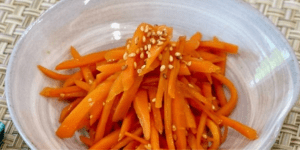
This month’s seed kit features Kyoto Red Carrots. To support our environment, seed kits are now available digitally. Scan the QR codes on the seed packets to download planting logs, delicious recipes, fun craft ideas, and coloring pages.
Kyoto Red Carrots
A sweet-tasting Japanese heirloom with a lovely shade of scarlet when mature. The characteristic color generally develops and deepens after the carrot reaches 3 inches in length.
Planting Instructions
Culture: Prefers cool weather, a sunny location, and loose, rich soil. Sow about 1/8 inch deep in rows that are about one foot apart. Thin to about 3 inches apart after plants are about 1-2 inches tall. To avoid disturbing roots of neighboring plants, thin by cutting the tops with scissors.
Water: Keep soil moist, but not saturated, until seedlings emerge in 12-18 days (longer if temperatures are very cold). Thereafter, provide even moisture on a regular basis to prevent over-drying of soil. Mulch lightly to conserve moisture.
Harvest: Reaches maturity in 70-90 days. Harvest by loosening the soil around the plant and gently pulling.
Culinary Tips: Great for roasting, grilling, or even juicing! Kyoto Red Carrots add an interesting color to salads.
More About Kyoto Red Carrots
The Kyoto Red Carrot is an important heirloom variety grown in the Kansai region of Japan. The Kansai region includes the cities of Kyoto, which once served as the capital of Japan, and Osaka. Introduced to Japan from China in the 16th century, the Kyoto Red Carrot is one of the historic agricultural products of the Kyoto prefecture. These historic agricultural products are collectively known as Kyōyasai, with Kyō meaning capital and Yasai meaning vegetable. The Kyoto Red Carrot or Kintoki ninjin, as it is known in Japan, was named for the Japanese folk hero Kintarō, who is also known as Sakata no Kintoki, a mountain-dwelling child who possessed superhuman strength and formed friendships with the animals of Mount Ashigara. Kintarō is often depicted wearing a bright red haragake (apron) or with red skin, much like the coloration of the Kyoto Red Carrot.
Traditionally eaten on the Japanese New Year, the Kyoto Red Carrot is very nutritious, serving as an excellent source of calcium, potassium, fiber, and vitamins C and E. This carrot variety also tastes great, with a softer consistency than most other varieties and a very sweet flavor. Kyoto Red Carrots can be prepared in many ways and are excellent for grilling, roasting, juicing, and even for desserts!
Japanese Carrot Kinpira
Serves: 2 Prep time: 5 minutes Cook Time: 10 minutes

Ingredients:
- 2 medium carrots, julienned
- 1 tbsp. sesame oil
- 1 tbsp. soy sauce
- 1 tbsp. Mirin
- 1 tbsp. maple syrup
- Pinch of sesame seeds
Instructions:
- Peel carrots, slice thinly, and cut slices into match sticks. Heat oil in a sauté pan on medium-low heat.
- Add julienne carrot and stir-fry until they start to color and slightly softened. Add maple syrup and mirin. Cook until moisture from the carrots has evaporated.
- Add soy sauce and turn the heat to low. Cook until all liquid has evaporated.
- Remove from heat and sprinkle with sesame seeds before serving.
Craft: Vegetable Stamping

You’ll Need:
- Carrots
- Xacto blade (used with adult supervision)
- Paint or ink
- Paper
Instructions:
- Chop off the end of the carrots. The ends should be about 1 inch in length. Try using a larger carrot for bigger stamps.
- Using the blade, carefully cut out your design into the flat end of the carrot. For example, try cutting out a flower, leaves, or even a butterfly.
- After cutting out the design, dip the stamp into some paint or ink and start stamping!


Add a comment to: January 2024: Kyoto Red Carrots